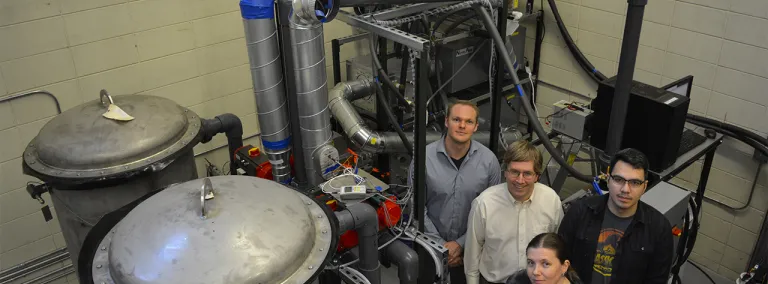SD Mines develops radon reduction system for LZ, SuperCDMS
Researchers from South Dakota university design major component for dark matter experiments
In the coming months, researchers will begin building the LUX-ZEPLIN dark matter experiment in a surface cleanroom at the Sanford Underground Research Facility (Sanford Lab). Once the detector is assembled, a team will carefully move the highly sensitive physics equipment to its home on the 4850 Level of Sanford Lab.
But before that can happen, there’s some work that needs to be done to ensure the experiment remains free of backgrounds that could interfere with the results. That’s where Dr. Richard Schnee and a team from the South Dakota School of Mines & Technology come in. Schnee, who is head of the physics department at SD Mines and a collaborator with LZ, heads up the SD Mines team that designed a radon reduction system for the experiment.
“Our detectors need very low levels of radon,” Schnee said. While the radon levels at the 4850 Level are safe for humans, they are too high for sensitive experiments like LZ, which go deep underground to escape cosmic radiation, Schnee explained. “We will take regular air from the facility and the systems will reduce the levels by 1,000 times or more.”
LZ, a second-generation dark matter experiment, will continue the search for WIMPs—weakly interacting massive particles—begun by its much smaller predecessor LUX (Large Underground Xenon), which was named the most sensitive of its kind in 2013 and again in 2016. LZ will hold 10 tons of liquid xenon, making it approximately 30 times larger and 100 times more sensitive than LUX.
LZ is designed so that if a dark matter particle collides with a xenon atom, it will produce a flash of light followed by a second flash of light when the electrons produced in the liquid xenon chamber drift to its top. The light pulses, picked up by a series of about 500 photo multiplier tubes lining the massive tank—over four times more than were installed in LUX—will carry the telltale fingerprint of the particles that created them.
Additionally, LZ will include a component not present in LUX—nine acrylic tanks filled with a liquid scintillator will form a veto system around the experiment, allowing researchers to better recognize a WIMP if they see one.
The system designed by the SD Mines team focuses specifically on filtering out radon particles to produce the ultra-pure air needed for the acrylic tanks and other components of LZ located in the same water tank that held LUX. The team is also helping ensure the parts used to build the experiments are relatively free of radon.
“The real problem for these super sensitive dark mater detectors are the radon daughters that are radioactive,” Schnee said. Even miniscule amounts of radioactive particles could contaminate and throw off the experiments—so the work of Schnee and his team is critical.
“We are very excited to have SD Mines as a partner in producing a major component for LZ, a world-leading dark matter experiment,” said Mike Headley, executive director the South Dakota Science and Technology Authority.
LZ is in a global race to discover dark matter. One competitor, SuperCDMS (Cryogenic Dark Matter Search), which will be located at SNOLab in Canada, is using germanium to search for WIMPs. And SD Mines is designing a radon reduction system for that experiment as well, Schnee said.
SNOLab is the deepest underground laboratory in North America at 6,800 feet deep. Although the experiments are competitors, Schnee said they actually complement each other as they are searching for dark matter in different areas. To use a metaphor, if dark matter were a lost child in a large cornfield, LZ would be looking in one part of the field, and SuperCDMS would be looking in another. Both projects will begin operations in the early 2020s. SD Mines is one of 26 institutions working on the SuperCDMS and one of 37 institutions working on LZ.
Headley attributes the expanding role of SD Mines’ in research at Sanford Lab and other international experiments to the Ph.D. program in South Dakota. SD Mines and the University of South Dakota offer a joint program and each graduated Ph.D. students in 2017.
“With the implementation of the Ph.D. program in 2012, South Dakota institutions are attracting high-quality professors and students,” Headley said. “It’s impressive to see them deliver such an important component for LZ, but also on other experiments around the world.”
To learn more about the physics program at SD Mines, go to www.sdsmt.edu; to read the full press release about SD Mines work on LZ and SuperCDMS, go to https://www.sdsmt.edu/Research/.
You can learn more about LZ at http://lz.lbl.gov/detector/and SCDMS at https://supercdms.slac.stanford.edu.
